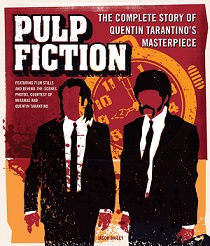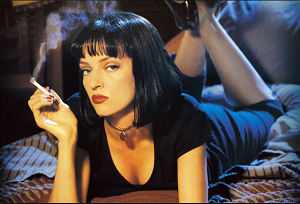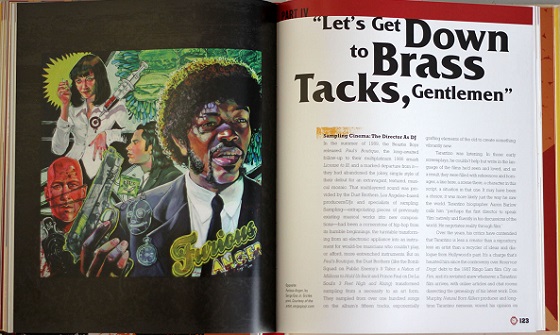 It’s not very often that a book about film can serve as both a coffee table book and a critical examination of a movie’s themes, structure, and cultural legacy, but Jason Bailey‘s Pulp Fiction: The Complete Story of Quentin Tarantino’s Masterpiece, published by Voyageur Press, does just that. It zig zags across low and high culture, covering all the bases in one unique package, just like the movie it profiles.
It’s not very often that a book about film can serve as both a coffee table book and a critical examination of a movie’s themes, structure, and cultural legacy, but Jason Bailey‘s Pulp Fiction: The Complete Story of Quentin Tarantino’s Masterpiece, published by Voyageur Press, does just that. It zig zags across low and high culture, covering all the bases in one unique package, just like the movie it profiles.
It also vividly recreates the early 90s film scene and illustrates the seismic shift in movies that happened when the hit men played by John Travolta and Samuel L. Jackson stopped outside the door of a mark to discuss what kind of message it sends when you give someone a foot massage.
Quentin Tarantino’s Pulp Fiction was a moment. I remember seeing it at least three times in the theater, and it played at Liberty Hall in Lawrence for what seemed like a year continuously after its release in October 1994. Pulp Fiction: The Complete Story of Quentin Tarantino’s Masterpiece does a great job of delving into what made the film so special from every angle, starting with Tarantino’s upbringing and influences and dissecting what it is about the movie’s unique narrative structure that elicits such pleasure.
 Jason Bailey isn’t alone in his endeavor. The book is filled with contributions by other authors that cover every conceivable tangent, including Adam Rosen‘s essay on the hard-boiled prose and tenets of early dime store novels. Of course, Tarantino only uses some of these elements as a springboard, interspersing his own exploitation sensibility and crackling dialogue, which is also covered at great length in the book.
Jason Bailey isn’t alone in his endeavor. The book is filled with contributions by other authors that cover every conceivable tangent, including Adam Rosen‘s essay on the hard-boiled prose and tenets of early dime store novels. Of course, Tarantino only uses some of these elements as a springboard, interspersing his own exploitation sensibility and crackling dialogue, which is also covered at great length in the book.
Some of the distinctive pop tunes used in Pulp Fiction are diagetic — woven into the fabric of the story — while others, like Dick Dale’s surf epic “Miserlou,” are used to lift an audience right out of their seats. Gary Graff‘s essay on Tarantino’s soundtrack choices reminded me of how inextricably linked some of these songs are now with the movie, while Bailey’s section about the music gives some interesting background information on Tarantino’s habit of making mix tapes for friends and how that informed his decision to put snippets of film dialogue between the tunes on the soundtrack.
 From a written content standpoint, Pulp Fiction: The Complete Story of Quentin Tarantino’s Masterpiece is equal parts trivia (with easily digestible “pulp facts” appearing throughout the book) and insightful consideration. From a graphic-design content standpoint, the book is a delight as well. Each page is laid out in short, easy-to-read paragraphs and illustrated with full-color shots from Tarantino’s movies, a wide array of fan-made artwork, and plenty of the historical images that informed Tarantino’s style.
From a written content standpoint, Pulp Fiction: The Complete Story of Quentin Tarantino’s Masterpiece is equal parts trivia (with easily digestible “pulp facts” appearing throughout the book) and insightful consideration. From a graphic-design content standpoint, the book is a delight as well. Each page is laid out in short, easy-to-read paragraphs and illustrated with full-color shots from Tarantino’s movies, a wide array of fan-made artwork, and plenty of the historical images that informed Tarantino’s style.
Film scholars may scoff at the layout of Pulp Fiction: The Complete Story of Quentin Tarantino’s Masterpiece, but there’s plenty of meaty discussion within its 200 pages. It’s also a book that will easily arouse the curiosity and intellect of more casual film fans as well, and may in fact inspire them to think more critically about movies. For thousands of movie fanatics like myself, Pulp Fiction was a window to film history and this book is overflowing with the kind of stuff that makes you want to learn more.








Comments on this entry are closed.